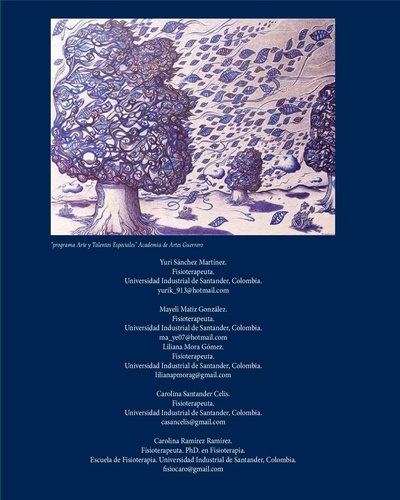Rehabilitación en la inhibición muscular artrogénica: revisión sistemática
Contenido principal del artículo
Autores
Yuri Sánchez Martínezyurik_913@hotmail.com
Mayeli Matiz González
ma_ye07@hotmail.com
Liliana Mora Gómez
lilianapmorag@gmail.com
Carolina Santander Celis
casancelis@gmail.com
Carolina Ramírez Ramírez
fisiocaro@gmail.com
Resumen
La Inhibición Muscular Artrogénica (IMA) es la inhibición refleja continua de los músculos que rodean una articulación lesionada. Dicha condición impide o retarda el proceso de rehabilitación hasta tanto esta no sea resuelta. Dentro de las intervenciones terapéuticas estudiadas para el tratamiento de la IMA se encuentran la estimulación eléctrica neuromuscular (NMES), la estimulación eléctrica nerviosa transcutánea (TENS), el ejercicio terapéutico y la crioterapia. Teniendo en cuenta que la IMA es un factor limitante en la rehabilitación de lesiones articulares, es relevante conocer las intervenciones terapéuticas usadas por el fisioterapeuta que pueden contribuir a controlar esta condición para favorecer la recuperación funcional y mejorar la calidad de vida de los pacientes con patologías articulares. Objetivo: revisar las intervenciones fisioterapéuticas que podrían ser más indicadas para disminuir el impacto de la IMA en la rehabilitación de pacientes con lesiones o patologías articulares. Método: Esta revisión incluyó el análisis de 9 artículos, los cuales fueron evaluados a través de la escala PEDro. Resultados: El TENS, el NMES, el ejercicio terapéutico y la crioterapia son las intervenciones terapéuticas que han mostrado cambios favorables en la activación y la fuerza muscular, contrarrestando los efectos perjudiciales de la IMA. La crioterapia es la modalidad física que mayores beneficios ofrece sobre el músculo inhibido. Conclusiones: Se requiere de estudios clínicos controlados que evalúen el efecto de las cuatro modalidades en condiciones clínicas reales, así mismo respecto a la crioterapia se requieren estudios para determinar la dosis apropiada
Detalles del artículo
Licencia
Aquellos autores/as que tengan publicaciones con esta revista, aceptan los términos siguientes:
- Los autores/as conservarán sus derechos de autor y garantizarán a la revista el derecho de primera publicación de su obra, el cuál estará simultáneamente sujeto a la Licencia de reconocimiento de Creative Commons que permite a terceros compartir la obra siempre que se indique su autor y su primera publicación esta revista.
- Los autores/as podrán adoptar otros acuerdos de licencia no exclusiva de distribución de la versión de la obra publicada (p. ej.: depositarla en un archivo telemático institucional o publicarla en un volumen monográfico) siempre que se indique la publicación inicial en esta revista.
- Se permite y recomienda a los autores/as difundir su obra a través de Internet (p. ej.: en archivos telemáticos institucionales o en su página web) antes y durante el proceso de envío, lo cual puede producir intercambios interesantes y aumentar las citas de la obra publicada. (Véase El efecto del acceso abierto).
Los autores que publican en la revista se acogen al código de licencia de Creative Commons Atribución 4.0 Internacional (CC BY 4.0)




Referencias
Basmajian, J. (1982). Terapéutica por el ejercicio (3ª Ed). Buenos Aires, Argentina: Editorial Panamericana.
Cheing, L. Hui, W. (2004). Would the addition of TENS to exercise training produce better physical performance outcomes in people with knee osteoarthritis than either intervention alone? Clinical Rehabilitation, 18, 487–497.
Evans, T; Ingersoll, C; Knight, K; Worrell, T. (1995). Agility Following the Application of Cold Therapy. Journal of Athletic Training, 30(3), 231–234.
Geborek, P; Moritz, U; Wollheim, F. (1989). Joint capsular stiffness in knee arthritis. Relationship to intraarticular volume, hydrostatic pressures, and extensor muscle function. The Journal of Rheumatology, 16(10), 1351–1358.
Hardy, M; Woodall, W. (1998). Therapeutic effects of heat, cold, and stretch on connective tissue. Journal of Hand Therapy, 11(2), 148–156.
Hart, J; Kuenze, C; Diduch, D; Ingersoll, D. (2014). Quadriceps muscle function after rehabilitation whith cryotherapy in patients with anterior cruciate ligament reconstruction. Journal of Athletic Training, 49(6), 733–739.
Hart, J; Kuenze, C; Pietrosimone, B; Ingersoll, C. (2012). Quadriceps Function in Anterior Cruciate Ligament-Deficient knees Exercising with Transcutaneous Electrical Nerve Stimulation and Cryotherapy: A Randomized Controlled Study. Clinical Rehabilitation, 26(11), 974–981.
Hopkins, J. (2006). Knee joint effusion and cryotherapy alter Lower chain kinetics and muscle activity. Journal of Athletic Training, 41(2), 177–184.
Hopkins, J; Ingersoll, C; Edwards, J; Klootwyk, T. (2001). Cryotherapy and transcutaneous electric neuromuscular stimulation decrease arthrogenic muscle inhibition of the vastus medialis after knee joint effusion. Journal of Athletic Training, 37(1), 25–31.
Hurley, M. (1999). No TitleThe role of muscle weakness in the pathogenesis of osteoarthritis. Rheumatic Disease Clinics of North America, 25(2), 283–298.
Kent, J; Le Blanc, R. (1996). Quantitation of central activation failure during maximal voluntary contractions in humans. Muscle Nerve, 19(7), 861–869.
Klykken, L; Pietrosimone, B; Kim, K; Ingersoll, C; Hertel, J. (2011). Motor-Neuron Pool Excitability of the Lower Leg Muscles After Acute Lateral Ankle Sprain. Journal of Athletic Training, 46(3), 263–269.
Kowal, M. (1983). Review of Physiological Effects of Cryotherapy. The Journal of Orthopaedic and Sports Physical Therapy, 5(2), 66–73.
McNair, P; Marshall, R; Maguire, K. (1996). Swelling of the knee joint. effects of exercise on quadriceps muscle strength. Archives of Physical Medicine and Rehabilitation, 77(9), 896–899.
Olivo, S; Macedo, L; Gadotti, I; Fuentes, J; Staton, T; Magee, D. (2008). Scales to assess the Quality of randomized controlled trials: A systematic review. Physical Therapy Journal, 88(2), 156–175.
Palmieri, R. Thomas, A. (2009). A neuromuscular mechanism of posttraumatic osteroarthritis associated with ACL injury. Exercise and Sport Sciences Reviews, 37(3), 147–153.
Palmieri, R; Thomas, A; Karvonen, C; Sowers, M. (2010). A clinical trial of neuromuscular electrical stimulation in improving quadriceps muscle strength and activation among women with mild and moderate osteoarthritis. Physical Therapy Journal, 90(10), 1441–1452.
Petterson, S; Snyder, L. (2006). The Use of Neuromuscular Electrical Stimulation to Improve Activation Deficits in a Patient With Chronic Quadriceps Strength Impairments Following Total Knee Arthroplasty. Journal of Orthopaedic and Sports Physical Therapy, 36(9), 678–685.
Pietrosimone, B; Hart, J; Saliba, S; Hertel, J; Ingersoll, C. (2009). Immediate effects of transcutaneous electrical nerve stimulation and focal knee joint cooling on quadriceps activation. Medicine and Science in Sports and Exercise, 41(6), 1175–1181.
Pietrosimone, B; McLeod, M; Lepley, A. (2012). A Theoretical Framework for Understanding Neuromuscular Response to Lower Extremity Joint Injury. Journal of Athletic Training, 4(1), 31–35.
Pietrosimone, B; Saliba, S; Hart, J; Hertel, J; Ingersoll, C. (2010). Contralateral effects of disinhibitory TENS on quadriceps function in people with knee osteoarthritis following unilateral treatment. North American Journal of Sports Physical Therapy, 5(3), 111–121.
Reeves, N; Maffulli, N. (2008). A case highlighting the influence of knee joint effusion on muscle inhibition and size. Nature Clinical Practice Rheumatology, 4(3), 153–158.
Sánchez Martínez, Y; Matiz González, M; Mora Gómez, L; Santander Celis, C; Ramírez Ramírez, C.
Reimann, B; Lephart, S. (2002). The sensoriomotor system, part I: The physiologic basis of functional joint stability. Journal of Athletic Training, 37(1), 71–79.
Rice, D. McNair, P. (2010). Quadriceps Arthrogenic Muscle Inhibition: Neural Mechanisms and Treatment Perspectives. Seminars in Arthritis and Rheumatism, 40(3), 250–266.
Rice, D; McNair, P; Dalbeth, N. (2009). Effects of cryotherapy on arthrogenic muscle inhibition using an experimental model of knee swelling. Arthritis y Rheumatism, 61(1), 78–83.
Rice, D; McNair, P; Lewis, G. (2011). Mechanisms of quadriceps muscle weakness in knee joint osteoarthritis: The effects of prolonged vibration on torque and muscle activation in osteoarthritic and healthy control subjects. Arthritis Research y Therapy, 13(5), 1–10.
Stackhouse, S; Dean, J; Lee, S; Binder, S. (2000). Measurement of central activation failure of the quadriceps femoris in healthy adults. Muscle Nerve, 23(11), 1706–1712.
Stevens, J; Balter, J; Wolfe, P; Eckhoff, D; Kohrt, W; et al. (2012). Early Neuromuscular Electrical Stimulation to Improve Quadriceps Muscle Strength After Total Knee Arthroplasty: A Randomized Controlled Trial. Physical Therapy Journal, 92(2), 210–226.
Stevens, J; Mizner, R; Mackler, L. (2004). Neuromuscular Electrical Stimulation for Quadriceps Muscle Strengthening After Bilateral Total Knee Arthroplasty: A Case Series. The Journal of Orthopaedic and Sports Physical Therapy, 34(1), 21–29.
Urbach, D; Berth, A; Awiszus, F. (2005). Effect of transcranial magnetic stimulation on voluntary activation in patients with quadriceps weakness. Muscle Nerve, 32(2), 164–169.


 PDF
PDF
 XML
XML










